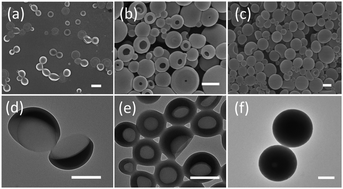Dipeptide concave nanospheres based on interfacially controlled self-assembly: from crescent to solid†
Abstract
Concave nanospheres based on the self-assembly of simple dipeptides not only provide alternatives for modeling the interactions between biomacromolecules, but also present a range of applications for purification and separation, and delivery of active species. The kinetic control of the peptide assembly provides a unique opportunity to build functional and dynamic nanomaterials, such as concave nanospheres. In this work, we report dipeptide-based concave nanospheres with structures from crescent-like to solid interior by interfacially controlled self-assembly in combination with covalent formation of building blocks, driven by synergistic thermodynamic and kinetic control. The thermodynamics of nucleation and assembly at the interfaces is governed by the gradual formation of bola-dipeptides (FF-GAn-FF), due to the covalent Schiff's base reaction between the glutaraldehyde (GA) and amino groups of diphenylalanine (FF), and non-covalent interactions of FF-GAn-FF building blocks for self-assembly. The kinetic growth process of concave nanospheres is determined by the formation rate of FF-GAn-FF bola-dipeptides and their interfacial nucleation rate. The concave nanospheres can be further functionalized easily by encapsulation of functional inorganic nanoparticles (e.g. magnetic nanoparticles) in the oil phase.



 Please wait while we load your content...
Please wait while we load your content...